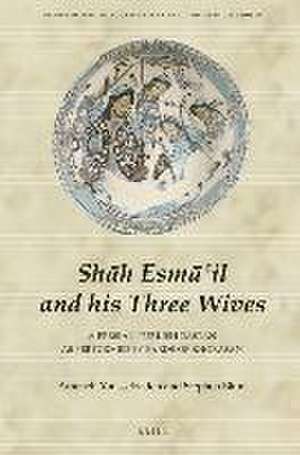Shāh Esmā‘il and his Three Wives: A Persian-Turkish Tale as Performed by the Bards of Khorasan: Studies on Performing Arts & Literature of the Islamicate World, cartea 12
Editat de Ameneh Youssefzadeh, Stephen Blumen Limba Engleză Hardback – 17 noi 2021
Preț: 521.07 lei
Preț vechi: 613.03 lei
-15% Nou
Puncte Express: 782
Preț estimativ în valută:
99.70€ • 104.38$ • 82.50£
99.70€ • 104.38$ • 82.50£
Carte indisponibilă temporar
Doresc să fiu notificat când acest titlu va fi disponibil:
Se trimite...
Preluare comenzi: 021 569.72.76
Specificații
ISBN-13: 9789004471214
ISBN-10: 9004471219
Dimensiuni: 155 x 235 mm
Greutate: 0.52 kg
Editura: Brill
Colecția Brill
Seria Studies on Performing Arts & Literature of the Islamicate World
ISBN-10: 9004471219
Dimensiuni: 155 x 235 mm
Greutate: 0.52 kg
Editura: Brill
Colecția Brill
Seria Studies on Performing Arts & Literature of the Islamicate World
Notă biografică
Ameneh Youssefzadeh, Ph.D. (1997), Nanterre University, is co-consulting editor of music at Encyclopaedia Iranica (New York). Her publications include several articles, book chapters, CDs, and a monograph, Les bardes du Khorassan iranien: le bakhshi et son répertoire (Paris 2002).
Stephen Blum is Professor of Music Emeritus at the City University of New York Graduate Center. His publications deal with general topics (composition, improvisation, modern music history, cultural interaction) and with specific musical practices of Iran, Kurdistan, Europe, and North America.
Stephen Blum is Professor of Music Emeritus at the City University of New York Graduate Center. His publications deal with general topics (composition, improvisation, modern music history, cultural interaction) and with specific musical practices of Iran, Kurdistan, Europe, and North America.
Cuprins
Preface
Acknowledgments
List of Figures, Maps, and Music Examples
Transliteration, Transcription, and Other Editorial Policies
1 The Multilingual Bards of Northern Khorasan
1 Peoples and Languages of Northern Khorasan
2 Storytelling in Multi-Ethnic Iran
3 The Khorasani Bakhshi
4 Contexts of Performance
2 Characters and Imagery of the Dāstān of Shāh Esmāʿil and Golzār Khānom
1 The Historical Shāh Esmāʿil II
2 Summary of the Dāstān in Rowshan’s Version
3 Attributes of the Characters
4 Women
5 Garden, Rose and Nightingale
6 Gazelles and Hunters
7 Journeys
8 Complaints
9 Threats and Maxims
3 Performance Practice of the Bakhshis
1 Verse and Tune
2 Melody-Types: Āhang and Maqām
3 Performance Styles
Episode 1
Episode 2
Episode 3
Episode 4
Episode 5
Episode 6
Episode 7
Episode 8
Episode 9
Episode 10
Episode 11
Episode 12
Episode 13
Episode 14
Episode 15
Episode 16
Episode 17
Episode 18
Episode 19
Episode 20
Episode 21
Episode 1
Episode 2
Episode 3
Episode 4
Episode 5
Episode 6
Episode 7
Episode 8
Episode 9
Episode 10
Episode 11
Episode 12
Episode 13
Episode 14
Episode 15
Episode 16
Episode 17
Episode 18
Episode 19
Episode 20
Episode 21
Appendix: Outline of Yegāneh’s Performance of Shāh Esmāʿil and Golzār Khānom
Glossary
Bibliography
Discography
Index of Dāstāns
Index of Names
Acknowledgments
List of Figures, Maps, and Music Examples
Transliteration, Transcription, and Other Editorial Policies
Part 1: The Bakhshis and Their Art
1 The Multilingual Bards of Northern Khorasan
1 Peoples and Languages of Northern Khorasan
2 Storytelling in Multi-Ethnic Iran
3 The Khorasani Bakhshi
4 Contexts of Performance
2 Characters and Imagery of the Dāstān of Shāh Esmāʿil and Golzār Khānom
1 The Historical Shāh Esmāʿil II
2 Summary of the Dāstān in Rowshan’s Version
3 Attributes of the Characters
4 Women
5 Garden, Rose and Nightingale
6 Gazelles and Hunters
7 Journeys
8 Complaints
9 Threats and Maxims
3 Performance Practice of the Bakhshis
1 Verse and Tune
2 Melody-Types: Āhang and Maqām
3 Performance Styles
Part 2: Text and Translation of Shāh Esmāʿil and Golzār Khānom
Episode 1
Episode 2
Episode 3
Episode 4
Episode 5
Episode 6
Episode 7
Episode 8
Episode 9
Episode 10
Episode 11
Episode 12
Episode 13
Episode 14
Episode 15
Episode 16
Episode 17
Episode 18
Episode 19
Episode 20
Episode 21
Part 3: Commentary
Episode 1
Episode 2
Episode 3
Episode 4
Episode 5
Episode 6
Episode 7
Episode 8
Episode 9
Episode 10
Episode 11
Episode 12
Episode 13
Episode 14
Episode 15
Episode 16
Episode 17
Episode 18
Episode 19
Episode 20
Episode 21
Appendix: Outline of Yegāneh’s Performance of Shāh Esmāʿil and Golzār Khānom
Glossary
Bibliography
Discography
Index of Dāstāns
Index of Names












